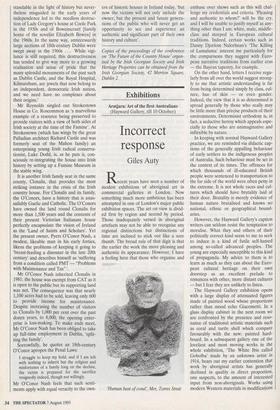Exhibitions
Incorrect response
Giles Auty
Recent years have seen a number of modest exhibitions of aboriginal art in commercial galleries in London. Now something much more ambitious has been attempted in one of London's major public exhibition spaces. The art on view is divid- ed first by region and second by period. Those inadequately versed in aboriginal artefacts may not be able to recognise any regional distinctions but distinctions of time are inclined to stick out like a sore thumb. The broad rule of that digit is that the earlier the work the more pleasing and authentic its appearance. However, I have a feeling here that those who organise and `Human bust of coral, Mer, Torres Strait enthuse over shows such as this will chal- lenge my credentials and criteria. 'Pleasing and authentic to whom?' will be the cry, and I will be unable to justify myself as any- thing other than I am: white, male, middle- class and steeped in European cultural traditions. Indeed, certain works such as Danny Djorlom Nalorlman's 'The Killing of Lumaluma' interest me particularly for the comparisons they suggest with Euro- pean narrative traditions from earlier eras — the Bayeux tapestry, for example.
On the other hand, letters I receive regu- larly from all over the world suggest strong- ly to me that artistic understanding is far from being determined simply by class, cul- ture, hue of skin — or even gender. Indeed, the view that it is so determined is spread generally by those who really may be little more than precise products of their environments. Determinist orthodoxy is, in fact, a seductive heresy which appeals espe- cially to those who are unimaginative and inflexible by nature.
In keeping with normal Hayward Gallery practice, we are reminded via didactic cap- tions of the generally appalling behaviour of early settlers to the indigenous peoples of Australia. Such behaviour must be set in the context of its times. The offences for which thousands of ill-educated British people were sentenced to transportation to the far side of the world were often petty in the extreme. It is not whole races and cul- tures which should have brutality laid at their door. Brutality is merely evidence of human nature brutalised and knows no national, ethnic or geographical bound- aries.
However, the Hayward Gallery's caption writers can seldom resist the temptation to moralise. What they and others of their politically correct kind seem to me to seek to induce is a kind of futile self-hatred among so-called advanced peoples. The young are especially susceptible to this kind of propaganda. My advice to them is to learn as much as they can about the Euro- pean cultural heritage on their own doorstep as an excellent prelude to romances with other, more distant cultures — but I fear they are unlikely to listen.
The Hayward Gallery exhibition opens with a large display of attenuated figures made of painted wood whose proportions rather than mood echo Giacometti. In a glass display cabinet in the next room we are confronted by the presence and reso- nance of traditional artistic materials such as coral and turtle shell which compare favourably with the new: painted hard- board. In a subsequent gallery one of the loveliest and most moving works in the whole exhibition, 'The White Ibis called Gobolba' made by an unknown artist in 1914, bears out my earlier contention that work by aboriginal artists has generally declined in quality in direct proportion, one suspects, to the amount of interested input from non-aboriginals. Works using modern Western materials in modifications of Western modes — Ginger Riley Munduwalawala's 'My Country' or Sambo Burra Burra's 'Hunting Story' — are roughly as successful as those by European artists might be who attempted traditional aboriginal artistic practices. Such mixes are seldom entirely comfortable.
Among more recent works, Les Midikuria's 'Petrol Sniffer' suggests sur- prisingly that even running a car may not be the most harmful way to use the world's dwindling fossil fuel reserves. More endearing by far were the `Dingos' of Lin Onus, a whole family of these characterful dogs observed in their natural habits and habitat but clad rather curiously in the strip of some obscure Old Boys rugby club. By contrast, works by Trevor Nickolls — 'Big Boss Hat' — and Gordon Bennett were much more political than perceptual and in line with most contemporary Western prac- tice. But like his counterparts hereabouts, Bennett is content to talk rather than paint a good picture: 'I wish to reinstate a sense of Aboriginal people within the culturally dominant system of representation as human beings, rather than as a visual sign that signifies the "primitive", the "noble savage" or some other European construct associated with black skin.'
The inexactitude of socio-political lan- guage disappoints me. The concept of the `noble savage' has nothing to do with hue any more than the maligned golliwog which originated in Europe as a doll brought back by sailors from the South Pacific — should provide the least offence to inhabitants of Toxteth even when placed on top of displays from a local jam factory. Fijian warriors were rightly proud of their hair but I fear all of us will be shamed in time by the attempted impositions of politi- cal correctness.



















































 Previous page
Previous page